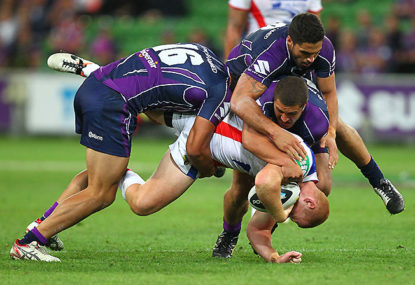As another NRL season kicks off, an on-field death is not inevitable but is certainly possible, as are spinal injuries. And serious concussions are a given.
And it’s because physical contact has become more a contest of the gymnasiums and coaching strategies, rather than tackling as it was once understood.
Older players will remember the time-honoured saying ‘they can’t run without legs’, and older, smaller backs were taught the technique of tackling rampaging forwards front-on and low. Former St George halfback Billy Smith was the exemplar, stopping front-rowers dead with his instruction-manual low, front-on tackles.
When New Zealand halfback Gary Freeman jumped high in the path of a rampaging Mal Meninga in a Test at Carlaw Park in 1993, it seemed impossibly brave. And it was. It was also a departure from all preceding teaching.
Now Phil Gould can commentate, “Don’t go low son, you’ll get hurt” when a halfback attempts the once-recommended front-on tackle. Penrith great Greg Alexander can refer to “a legs tackle”, differentiating it from the multiple defender monsterings.
Those monsterings are no more frightening than when a front-row forward returns the ball from a kick-off.
As a television watcher is insulated from the sickening sound a ringside watcher hears when a boxing glove strikes facial flesh, so the television football viewer or fan in the grandstand is insulated from the sickening sound when 110 kilograms of gym-produced strength meets 110 kilograms of gym-produced strength.
The front-row kick returner winds up and storms 20 metres before usually coming to a full stop as he hits a brick wall in the form of the first-tackler going high. Then another tackler goes low, and a third comes in over the top.
The was the sequence when Canterbury’s James Graham was last man in, colliding head-to-head with Souths’ Sam Burgess, fracturing Burgess’ cheekbone in last year’s grand final.
It’s frightening, and it’s a sequence repeated from virtually every kick-off in every game. That’s the way the players are coached and why they do the weights; so the brick wall can stop the runaway truck. Dominance leads to no slipped pass, then a slow play-the-ball, and a moving defence on to the advantage line.
Just as frightening is the sight of a player bent backwards by multiple tacklers. No matter the increased strength and flexibility of the modern-day player, ankle and knee injuries must follow. The human body wasn’t meant to take the kick-off and bending-back pressure.
With Jarryd Hayne signing with the San Francisco 49ers, a comparison with American football is instructive.
After an estimated 19 college football fatalities, President Theodore Roosevelt made a famous intervention in 1908, leading to gridiron being temporarily banned and replaced by Gaelic football in schools. This in turn led to the formation of the national professional association in 1910, the introduction of helmets and protective padding, and modern American football.
The National Centre for Catastrophic Sports Injury Research has estimated there were 1006 deaths throughout the system from 1931-2006 and 683 indirect deaths. The statistics may be disputed but the point is made: it’s a dangerous game, and the stat that shows there have been more concussions than in other sports in the US is not disputed.
To stress the danger, three high school players died in one, thankfully anomalous, week last October.
NRL players don’t wear helmets, which would only increase the danger, but head clashes are becoming more frequent, and those advances in gymnasium and training techniques will only make players stronger and fitter, and the collisions more frightening.
What can be done?
Well, when the wrestle became part of the play-the-ball, the NRL referees got their own wrestling expert down to training.
They were shocked.
Their man showed how that seeming jumble of arms and legs was in fact a carefully rehearsed tactic. He also showed the inherent danger; of how the tackled player had come within centimetres of a catastrophic spinal injury many times. Only a miracle had thwarted those extra few centimetres.
Referees can’t deconstruct every incident that happens in seconds. As players become stronger and fitter and the game faster, at some point fewer players and fewer replacements would seem a future solution – or part of one, at least.
Meanwhile, there is the compensation of watching a forward who humanises the game, a forward like George Rose. In these days of gym-created identikit athletes called forwards, Rose is a throwback to when men were men and scrums were scrums. A man unafraid of a protuberant stomach, a man who looks like he has no taste for gyms, who brings his own distinctive style to what was once the bargers’ art.
An articulate man with a sense of humour and a ready, self-deprecating quip. In short, a champion, yet he has struggled to find a permanent home and time on the field.
Kerry O’Keefe offered the immortal line, “When Fui Fui Moi Moi is going well, rugby league is going well.”
My take: “A game that can’t accommodate an outsized personality like George Rose is only half a game.”






























































































